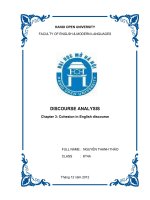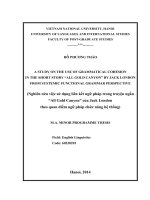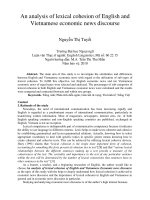UEfAP cohesion
Bạn đang xem bản rút gọn của tài liệu. Xem và tải ngay bản đầy đủ của tài liệu tại đây (71.81 KB, 1 trang )
UEfAP Cohesion
Grammar in EAP
Cohesion: Introduction
It is the responsibility of the writer in English to make it clear to the reader how various parts of the text
are connected. These connections can be made explicit grammatically and lexically by the use of
different reference words. Every text has a structure. It is not just a random collection of sentences.
The parts that make up the text are related in a meaningful way to each other. In order to make these
relationships in the text clear, it is necessary to show how the sentences are related. Words like "it",
"this", "that", "here", "there" etc. refer to other parts of the text. You need to understand how to use
these connections or links.
There are four main types of links used in academic texts: reference, ellipsis and substitution,
conjunction and lexical cohesion (Halliday and Hasan, 1976).
Flow of information in paragraphs
In order for a text to be easy to read, the information in it must flow easily from one sentence to the
next. To do this it is important to structure your information clearly and signal exactly what you want to
say by the use of signalling words.
Cohesion: Signalling
It is the responsibility of the writer in English to make it clear to the reader how various parts of the text
are connected. These connections can be made explicit by the use of different signalling words.
CleftSentences
Cleftsentences can also help with information flow by linking clauses:
For centuries, London had been growing as a commercial port of world importance. But it was in the
north of England that industrial power brought new prosperity to the country.
/>
1/1









